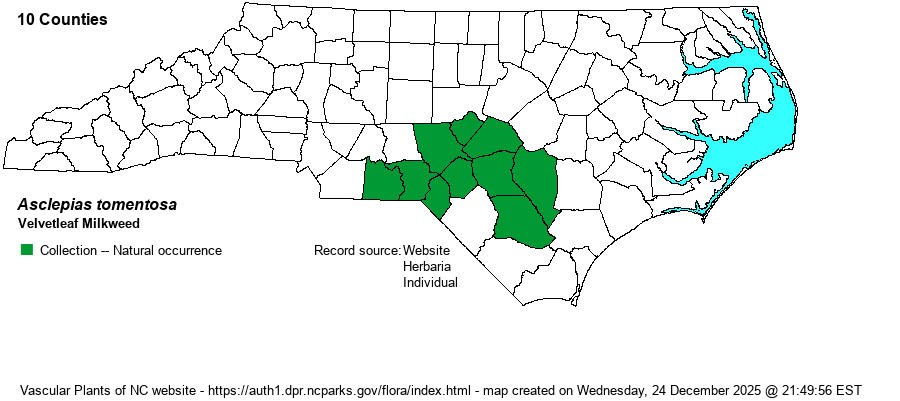| Author | Elliott | |
| Distribution | Essentially only in the Sandhills portion of the Coastal Plain, though it does ranges slightly eastward into the flatter parts of the Coastal Plain (to Sampson and Bladen counties). In 2023, Becky Dill photographed the species in the eastern edge of the Piedmont, in Anson County (iNaturalist record); this image is now a specimen at NCU herbarium.
This is a quite localized and scarce species of the Southern Coastal Plain. It has a disjunct range: 1) the Sandhills region of southern NC south to central SC; 2) most of FL; and 3) eastern TX. It is absent from AL (historical at least), MS, and LA. | |
| Abundance | Uncommon to locally infrequent in the Sandhills, not necessarily in strongly fire-managed natural areas such as Fort Bragg and the Sandhills Game Land (as with most other scarce Sandhills species). Rare eastward into Sampson and Bladen counties; extremely rare into the eastern edge of the Piedmont. This is a Watch List species. | |
| Habitat | This is a species of typical pine/scrub oak sandhills habitats, normally found under stands of Longleaf Pine (Pinus palustris). It is more capable of existing in fire-suppressed sandhills than most other herbaceous species, though some sort of disturbance (such as thinnings of pines) is normally required for its survival, as it can be found in various types of sandy clearings. The species is puzzling in that it is seemingly absent from what appear to be perfectly managed pine/scrub oak habitats. | |
| Phenology | Blooms from May to June, and fruits mainly in July. | |
| Identification | This is rather short milkweed, growing to about 1-1.5 feet tall, with one to several stems, but stems are not branched. It has 3-6 pairs of opposite leaves, with short petioles and quite variable shaped leaves, depending on the individual plant. Most leaves are elliptical, about 3 inches long and about 1-inch wide, with the margins of the leaves rather wavy and not in a single plane. As with other milkweeds, the flowers grow in several terminal or upper axil clusters (umbels), each quite large for the smallish size of the plant, about 2 inches across. The flowers, however, are a pale green to light yellowish-green, not too much different from the darker green color of the leaves, and thus even in flower the plant does not attract much attention. In fact, biologists will often walk past non-flowering plants owing to their fairly small size, and some might even overlook a flowering plant -- especially as this species typically grows singly or just a few plants scattered over an acre of habitat. But, the plants are worth a close look, as the flowers are quite large, each nearly 1-inch across, and as it might be a good while before more flowering plants will be found. | |
| Taxonomic Comments | None
| |
| Other Common Name(s) | Sandhills Milkweed. The main common name refers to the moderate dense hairs on the leaves, but one would not normally use hairs for the identification for any NC milkweed species; leaves and flowers are typically sufficient for identification. | |
| State Rank | S3 | |
| Global Rank | G4 | |
| State Status | W1 | |
| US Status | | |
| USACE-agcp | | |
| USACE-emp | | |

